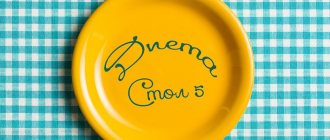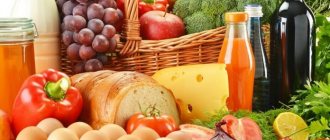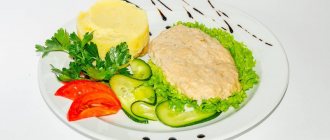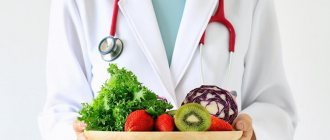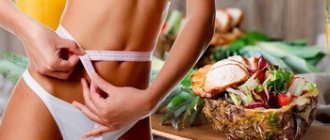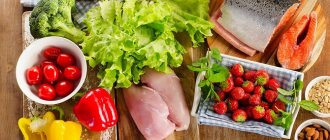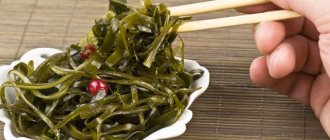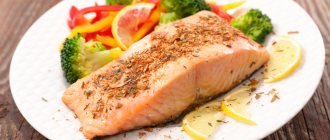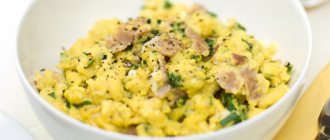General rules
Obesity is a pathology characterized by increased deposition of fat in the body, leading to excess weight. There are many types of obesity, but now we are talking about nutritional obesity, in which obesity is the leading symptom of the disease, and not a consequence or symptom of nervous or primary endocrine diseases (diabetes , hypothyroidism , Itsenko -Cushing syndrome ).
Nutritional obesity develops when calorie intake exceeds the body's energy expenditure and is characterized by a gradual increase in body weight with a relatively uniform distribution of subcutaneous adipose tissue.
There are 4 degrees of obesity:
- at stage I, the actual body weight exceeds the norm by 15-29%;
- at stage II by 30-49%;
- at stage III – by 50-100%;
- at stage IV – more than 100%.
Everyone can determine approximately their normal weight using Brock's formula (height in centimeters minus 100). The fundamental method of treating obesity is diet, combined with physical activity.
The main diet for obesity is a diet with reduced energy value - therapeutic Diet No. 8 ( Table No. 8 according to Pevzner) and its variants 8A and 8o. The level of modification of the energy intensity of the diet is determined by the degree of obesity and the individual energy needs of the patient’s body, taking into account the level of physical activity, age, gender, and labor intensity. The energy value of the main diet varies between 1700-1800 Kcal (90-110 g proteins of which 60% are animal, 80-85 g fats - of which 30% are vegetable and 150 - 170 g carbohydrates); sodium chloride consumption is limited to 5-6 g/day; free liquid - at the level of 1-1.5 liters.
The protein content in the diet should be within normal limits and provide 15–20% of the total calorie intake with a slight predominance of animal proteins. Various types of legumes (peas, lentils, beans) and soy products are mainly used as a source of vegetable protein. Animal proteins are provided by including lean meats (up to 150 g/day) in the diet - veal, beef, chicken, rabbit, turkey, limiting pork and excluding fatty meat (duck, goose), as well as meat products (ham, sausage, canned food) ). Only low-fat varieties of fish are used. It is useful to include seafood (squid, shrimp, mussels).
When compiling a diet, it is important to completely exclude quickly absorbed carbohydrates (sugar, honey, jams, sweets, preserves), which can be replaced with sweeteners ( saccharin , aspartame ). The use of sweeteners ( fructose , xylitol , sorbitol ) that have a sufficiently high energy value is impractical. It is recommended to distribute carbohydrates evenly between all meals. It is recommended to use foods with a low glycemic index in the diet. Bread is limited to 100 g per day or excluded altogether.
In order to create a feeling of fullness in the diet, the consumption of foods containing a lot of dietary fiber (up to 30-40 g/day) is increased - dietary varieties of bread, raw vegetables, fruits, grains, bran (barley, oat and wheat). These products are low in calories and have a large volume.
Fresh cucumbers
Radishes, fresh cucumbers, all types of cabbage, zucchini, pumpkin, turnips, and tomatoes are widely included in the diet, and it is recommended to consume them partially raw. Dishes made from green peas, potatoes, carrots, beets, rutabaga (up to 200 g/day), as well as pickled and salted vegetables are limited.
It is extremely important to control in the diet not only the quantity, but also the quality composition of fat. When limiting fat to 30% of the total daily calorie intake through the use of predominantly low-fat/low-fat foods, it is important to maintain an equal ratio between mono/saturated and polyunsaturated fatty acids. The diet includes low-fat milk and fermented milk products, as well as low-fat cottage cheese, both in its natural form and in the form of puddings, cheesecakes, and casseroles.
Avoid sweet cheeses, cream, fatty cottage cheese, fermented baked milk, fatty cheeses, and baked milk. It is important to avoid including hidden fats in your diet, such as those found in smoked meats, offal, sausages, cheeses, ice cream, nuts, confectionery, and cookies. omega-3 PUFAs in the diet , which are rich in flaxseed and soybean oil, halibut, and capelin.
It is important to provide the diet with sufficient content and ratio of minerals and trace elements, vitamins . It is extremely useful to include foods rich in potassium salts (seafood, soybeans, potatoes, beans, dried fruits, cabbage, black currants, apricots) and magnesium (buckwheat, carrots, rose hips, bran), iodine (seafood, seaweed), antioxidant vitamins ( E , A , C ) - vegetable oils, rosehip decoction, fruits, berries and vegetables.
Salt intake is limited to 5 g/day. At the same time, in the presence of severe persistent hypertension , salt may not be added to food.
All foods that stimulate the appetite (savory snacks, seasonings, strong broths and sauces), as well as alcoholic drinks, are excluded from the diet.
Drinking regimen - 1.5 liters on average per day in the form of mineral and drinking water, herbal teas, unsweetened fruit, vegetable and berry juices. It is recommended to drink water when you feel hungry, which helps suppress it for a while.
Against the background of the diet, it is recommended to carry out fasting days (fruit and vegetable, cottage cheese and kefir) 1-3 times a week. Culinary processing of products involves cooking food mainly boiled, steamed and stewed using appropriate technologies.
The essence of the diet
The Pevzner table for obesity aims to reduce and stabilize the patient’s weight, which has increased as a result of disruptions in metabolic processes and the presence of bad eating habits. Therapeutic nutrition organizes the gradual elimination of extra pounds with tangible health benefits:
- Lipid metabolism in the body is restored;
- Blood sugar levels decrease;
- Blood pressure stabilizes;
- Cholesterol is normalized.
Table No. 8 in terms of energy value ranges from 1700-2000 calories per day. It is by reducing the calories consumed that a person begins to lose weight.
Chemical composition of the daily diet:
- 150-200 grams of carbohydrates (10-15 grams of sugar);
- 90-100 grams of protein (60% animals);
- 80-90 grams of fat (30% vegetable).
The volume of free liquid is limited; it should not exceed 1.5 liters per day, since liquid can activate taste buds and awaken appetite. The amount of table salt varies within 4-7 grams of the daily requirement; nutritionists often prescribe a completely bland menu. Thanks to such restrictions, it will be possible to normalize water-salt metabolism, which is usually disturbed in obesity.
The duration of therapeutic nutrition can last from a couple of weeks to a couple of months. The diet is useful not only for severe obesity, but also as a preventive measure for those who are predisposed to gaining excess weight.
Table No. 8 can be observed only in the absence of diseases of the liver, circulatory system and gastrointestinal tract - in these cases the menu is subject to adjustment.
Varieties
At higher (3-4) degrees of obesity, varieties of Diet 8 with reduced energy consumption of the diet are prescribed.
Diet No. 8A - energy value is reduced to 1200-1300 Kcal (proteins -80 g, of which up to 70% are of animal origin; fats -60 g, of which 30-35% are vegetable fats and carbohydrates - 130 g). Fats are limited mainly due to vegetable fats and carbohydrates by excluding simple and limiting complex carbohydrates. Free fluid intake is reduced to 0.8–1.2 l/day.
If Diets No. 8 and 8A are insufficiently effective (for grade III-IV obesity), Diet No. 8o . Energy value is 600-800 Kcal (40-50 g - proteins; 30-40 g - fats and 50-70 g - carbohydrates). It is prescribed for a short period (up to one month) and is carried out only under the supervision of doctors in a hospital.
At the same time, fasting days per week are practiced: apple (up to 1.5 kg of apples/day), cottage cheese (500 grams of low-fat cottage cheese with 2-3 glasses of green tea), watermelon (up to 1.5-2 kg of watermelon pulp), kefir (1.5 liters of kefir/day) and others).
When using Diets 8A and 8o , you should not start fasting immediately with very low-calorie diets. Start with a moderately reduced Diet No. 8 and then gradually switch to low-energy diets. This will allow the body to gradually adapt to a low-calorie diet and avoid such a phenomenon as “food depression.”
When prescribing low-calorie diets, it is necessary to monitor not only weight, but also the general condition of the body. If side effects appear, such as high fatigue, weakness, nausea , cold intolerance, the characteristic odor of acetone, diarrhea / constipation , dry skin, dysmenorrhea / amenorrhea , heart rhythm disturbances, it is necessary to begin exiting such a diet.
Indications and contraindications
Table number 8 is indicated for all obese people; in the presence of concomitant pathologies of the cardiovascular and digestive systems, the diet is changed to suit the specific patient.
It should not be prescribed to patients with severe diseases of the cardiovascular, respiratory and digestive systems, since in this case an individual diet is required; it is important to provide the body with all the necessary nutrients.
Diet No. 8 is prescribed for mild obesity (degree 1-2). Its variants - 8A and 8O are used for severe obesity of 3-4 degrees, when the weight is significantly higher than normal, and the main diet does not help.
Before prescribing a low-calorie diet, you need to be examined by a gastroenterologist or therapist for hidden pathology, otherwise such a diet may result in negative consequences.
The mandatory minimum examination is a general and biochemical blood test, a general urinalysis, an ECG, and an ultrasound of the abdominal organs.
Authorized Products
Bran and black bread are allowed in the diet (up to 100 g/day). Soups are prepared mainly with vegetable broth, and 1-2 times a week soups with weak, low-fat meat or fish broth with the addition of vegetables or potatoes, without salt, are allowed. The meat for the soup is pre-cooked for 10-15 minutes and the resulting broth is drained, after which the “secondary” broth is boiled.
For second courses, lean boiled meat (no more than 100 g/day) of poultry, turkey, rabbit or lean beef is used. From fish, the diet can include up to 150 g of low-fat varieties (pike perch, pike, cod, carp), as well as seafood - shrimp, mussels, squid. Vegetables (cucumbers, tomatoes, various types of cabbage, zucchini and lettuce) are used as a side dish (up to 200 g/day).
Dairy products include yogurt, low-fat milk, kefir, and low-fat cottage cheese in the diet. As snacks, vinaigrettes and salads seasoned with vegetable oil are introduced into the diet.
Drinks in the diet include black and green tea, weak natural coffee, mineral water, sour fruit and berry juices.
Drinks - tea, tea with milk, tomato juice, juices from sour varieties of berries and fruits, alkaline. Total liquid (together with soup, milk, curdled milk, compote, drinks) up to 5-6 glasses per day.
Table of permitted products
| Proteins, g | Fats, g | Carbohydrates, g | Calories, kcal | |
Vegetables and greens | ||||
| greenery | 2,6 | 0,4 | 5,2 | 36 |
| squash caviar | 1,2 | 7,0 | 7,4 | 97 |
| zucchini | 0,6 | 0,3 | 4,6 | 24 |
| broccoli | 3,0 | 0,4 | 5,2 | 28 |
| cauliflower | 2,5 | 0,3 | 5,4 | 30 |
| cucumbers | 0,8 | 0,1 | 2,8 | 15 |
| soybeans | 34,9 | 17,3 | 17,3 | 381 |
| tomatoes | 0,6 | 0,2 | 4,2 | 20 |
Fruits | ||||
| baked sweet and sour apples | 0,5 | 0,5 | 12,3 | 59 |
Cereals and porridges | ||||
| buckwheat | 4,5 | 2,3 | 25,0 | 132 |
| oatmeal with water | 3,0 | 1,7 | 15,0 | 88 |
| wheat bran | 15,1 | 3,8 | 53,6 | 296 |
| rye bran | 11,2 | 3,2 | 32,0 | 221 |
Bakery products | ||||
| whole grain bread | 10,1 | 2,3 | 57,1 | 295 |
Dairy | ||||
| skim milk | 2,0 | 0,1 | 4,8 | 31 |
| kefir product bio balance 0% | 3,2 | 0,1 | 4,5 | 32 |
Cheeses and cottage cheese | ||||
| cottage cheese 0% (low fat) | 16,5 | 0,0 | 1,3 | 71 |
Meat products | ||||
| lean beef | 22,2 | 7,1 | 0,0 | 158 |
| rabbit | 21,0 | 8,0 | 0,0 | 156 |
Bird | ||||
| boiled chicken breast | 29,8 | 1,8 | 0,5 | 137 |
| boiled chicken drumstick | 27,0 | 5,6 | 0,0 | 158 |
| boiled chicken fillet | 30,4 | 3,5 | 0,0 | 153 |
| boiled turkey fillet | 25,0 | 1,0 | — | 130 |
Eggs | ||||
| hard-boiled chicken eggs | 12,9 | 11,6 | 0,8 | 160 |
Fish and seafood | ||||
| boiled fish | 17,3 | 5,0 | 0,0 | 116 |
| squid | 21,2 | 2,8 | 2,0 | 122 |
| shrimps | 22,0 | 1,0 | 0,0 | 97 |
| mussels | 9,1 | 1,5 | 0,0 | 50 |
| zander | 19,2 | 0,7 | — | 84 |
| cod | 17,7 | 0,7 | — | 78 |
| pike | 18,4 | 0,8 | — | 82 |
Oils and fats | ||||
| vegetable oil | 0,0 | 99,0 | 0,0 | 899 |
| linseed oil | 0,0 | 99,8 | 0,0 | 898 |
Non-alcoholic drinks | ||||
| mineral water | 0,0 | 0,0 | 0,0 | — |
| green tea | 0,0 | 0,0 | 0,0 | — |
| black tea | 20,0 | 5,1 | 6,9 | 152 |
Juices and compotes | ||||
| tomato juice | 1,1 | 0,2 | 3,8 | 21 |
| rose hip juice | 0,1 | 0,0 | 17,6 | 70 |
| * data is per 100 g of product | ||||
General characteristics of dietary table No. 8
Diet No. 8 satisfies a person’s physiological needs for nutrients and energy. The calorie content of the diet is moderately reduced by reducing the amount of simple carbohydrates and animal fats. The diet is enriched with dietary fiber and vegetable fats. Fluids are moderately limited. Food is prepared steamed or boiled without salt. Stewing and baking are acceptable. It is recommended to exclude or limit fried, mashed and chopped foods. Diet No. 8 provides for fractional meals 4–6 times a day.
Fully or partially limited products
Products such as wheat bread and bakery products, all types of fatty meat (pork, goose, duck) and meat products from them (ham, sausages, sausages, canned food), as well as fatty fish, pork, beef and confectionery fat are completely excluded from the diet. .
Any strong broths based on meat, fish and mushrooms, fried, salted and smoked foods, fried eggs, fatty cottage cheese, cream, sweet yogurt, sweet cheeses, baked milk, fermented baked milk, salty and fatty cheeses are excluded. It is not allowed to include rice, legumes, oatmeal and semolina, pasta, spicy and fatty snacks, spices and mayonnaise in the diet.
Bananas, dates, grapes, figs, raisins and sweet varieties of other fruits are prohibited. It is not allowed to include confectionery, chocolate, sweets, sugar, honey, jam, preserves, ice cream, jelly and any alcohol-containing drinks in the diet.
Foods that stimulate appetite are excluded: horseradish, pepper, mustard, various seasonings and hot fatty sauces. The consumption of salt, butter, green peas, potatoes, carrots, beets, rutabaga (up to 200 g per day), as well as pickled and salted vegetables and mushrooms is limited. As for drinks, all juices from sweet fruits, cocoa, and tea with milk are prohibited.
Table of prohibited products
| Proteins, g | Fats, g | Carbohydrates, g | Calories, kcal | |
Vegetables and greens | ||||
| beans | 6,0 | 0,1 | 8,5 | 57 |
| peas | 6,0 | 0,0 | 9,0 | 60 |
| green peas | 5,0 | 0,2 | 13,8 | 73 |
| fried potato | 2,8 | 9,5 | 23,4 | 192 |
| carrot | 1,3 | 0,1 | 6,9 | 32 |
| beet | 1,5 | 0,1 | 8,8 | 40 |
| beans | 7,8 | 0,5 | 21,5 | 123 |
| horseradish | 3,2 | 0,4 | 10,5 | 56 |
Fruits | ||||
| melon | 0,6 | 0,3 | 7,4 | 33 |
Mushrooms | ||||
| mushrooms | 3,5 | 2,0 | 2,5 | 30 |
Nuts and dried fruits | ||||
| nuts | 15,0 | 40,0 | 20,0 | 500 |
| dried fruits | 2,3 | 0,6 | 68,2 | 286 |
| sunflower seeds | 20,7 | 52,9 | 3,4 | 578 |
Snacks | ||||
| potato chips | 5,5 | 30,0 | 53,0 | 520 |
Cereals and porridges | ||||
| white rice | 6,7 | 0,7 | 78,9 | 344 |
Flour and pasta | ||||
| pasta | 10,4 | 1,1 | 69,7 | 337 |
| noodles | 12,0 | 3,7 | 60,1 | 322 |
| pancakes | 6,1 | 12,3 | 26,0 | 233 |
| vareniki | 7,6 | 2,3 | 18,7 | 155 |
| pancakes | 6,3 | 7,3 | 51,4 | 294 |
| dumplings | 11,9 | 12,4 | 29,0 | 275 |
Bakery products | ||||
| bagels | 16,0 | 1,0 | 70,0 | 336 |
| white bread crackers | 11,2 | 1,4 | 72,2 | 331 |
| wheat bread | 8,1 | 1,0 | 48,8 | 242 |
Confectionery | ||||
| jam | 0,3 | 0,2 | 63,0 | 263 |
| candies | 4,3 | 19,8 | 67,5 | 453 |
Cakes | ||||
| cake | 4,4 | 23,4 | 45,2 | 407 |
Chocolate | ||||
| chocolate | 5,4 | 35,3 | 56,5 | 544 |
Raw materials and seasonings | ||||
| mustard | 5,7 | 6,4 | 22,0 | 162 |
| ginger | 1,8 | 0,8 | 15,8 | 80 |
| mayonnaise | 2,4 | 67,0 | 3,9 | 627 |
| honey | 0,8 | 0,0 | 81,5 | 329 |
| sugar | 0,0 | 0,0 | 99,7 | 398 |
| vinegar | 0,0 | 0,0 | 5,0 | 20 |
Dairy | ||||
| milk 3.2% | 2,9 | 3,2 | 4,7 | 59 |
| condensed milk | 7,2 | 8,5 | 56,0 | 320 |
| kefir 3.2% | 2,8 | 3,2 | 4,1 | 56 |
| cream 20% (medium fat content) | 2,8 | 20,0 | 3,7 | 205 |
| cream 35% (fat) | 2,5 | 35,0 | 3,0 | 337 |
| sour cream 25% (classic) | 2,6 | 25,0 | 2,5 | 248 |
| Ryazhenka | 2,8 | 4,0 | 4,2 | 67 |
Cheeses and cottage cheese | ||||
| cheese | 24,1 | 29,5 | 0,3 | 363 |
| cottage cheese 18% (fat) | 14,0 | 18,0 | 2,8 | 232 |
Meat products | ||||
| fatty pork | 11,4 | 49,3 | 0,0 | 489 |
| salo | 2,4 | 89,0 | 0,0 | 797 |
| bacon | 23,0 | 45,0 | 0,0 | 500 |
| ham | 22,6 | 20,9 | 0,0 | 279 |
| pork stew | 13,0 | 35,0 | 0,0 | 367 |
Sausages | ||||
| smoked sausage | 28,2 | 27,5 | 0,0 | 360 |
Bird | ||||
| fried chicken | 26,0 | 12,0 | 0,0 | 210 |
| duck | 16,5 | 61,2 | 0,0 | 346 |
| goose | 16,1 | 33,3 | 0,0 | 364 |
Eggs | ||||
| fried egg | 11,9 | 15,3 | 0,7 | 192 |
Fish and seafood | ||||
| pink salmon | 20,5 | 6,5 | 0,0 | 142 |
| Red caviar | 32,0 | 15,0 | 0,0 | 263 |
| cod roe | 24,0 | 0,2 | 0,0 | 115 |
| salmon | 19,8 | 6,3 | 0,0 | 142 |
| herring | 16,3 | 10,7 | — | 161 |
| cod (liver in oil) | 4,2 | 65,7 | 1,2 | 613 |
| trout | 19,2 | 2,1 | — | 97 |
Oils and fats | ||||
| peasant unsalted butter | 1,0 | 72,5 | 1,4 | 662 |
| vegetable-fat spread | 0,0 | 40,0 | 0,0 | 360 |
| cod liver oil | 0,0 | 99,8 | 0,0 | 898 |
| solid confectionery fat | 0,0 | 99,8 | 0,0 | 898 |
| rendered pork fat | 0,0 | 99,6 | 0,0 | 896 |
Alcoholic drinks | ||||
| white dessert wine 16% | 0,5 | 0,0 | 16,0 | 153 |
| vodka | 0,0 | 0,0 | 0,1 | 235 |
| cognac | 0,0 | 0,0 | 0,1 | 239 |
| liquor | 0,3 | 1,1 | 17,2 | 242 |
| beer | 0,3 | 0,0 | 4,6 | 42 |
Juices and compotes | ||||
| jelly | 0,2 | 0,0 | 16,7 | 68 |
| * data is per 100 g of product | ||||
Example menu
The weekly dietary menu for stage 2 obesity is given below.
Monday
| Breakfast |
|
| Lunch |
|
| Dinner |
|
| Afternoon snack |
|
| Dinner |
|
Tuesday
| Breakfast |
|
| Lunch |
|
| Dinner |
|
| Afternoon snack |
|
| Dinner |
|
Wednesday
| Breakfast |
|
| Lunch |
|
| Dinner |
|
| Afternoon snack |
|
| Dinner |
|
Thursday
| Breakfast |
|
| Lunch |
|
| Dinner |
|
| Afternoon snack |
|
| Dinner |
|
Friday
| Breakfast |
|
| Lunch |
|
| Dinner |
|
| Afternoon snack |
|
| Dinner |
|
Saturday
| Breakfast |
|
| Lunch |
|
| Dinner |
|
| Afternoon snack |
|
| Dinner |
|
Sunday
| Breakfast |
|
| Lunch |
|
| Dinner |
|
| Afternoon snack |
|
| Dinner |
|
Diet 8A with insufficiently effective weight loss , the weekly menu for the set of products is not fundamentally different. The main difference is the reduction in the amount of consumption of almost all products. Thus, the amount of meat and fish is reduced to 80 g per day, the consumption of cereals and vegetable oil is reduced.
Below is an example of Diet No. 8A for one day:
| Breakfast |
|
| Lunch |
|
| Dinner |
|
| Afternoon snack |
|
| Dinner |
|
For children
Primary obesity in children is in most cases caused by overeating and lack of exercise. Parents systematically overfeed their children with high-calorie foods, abusing easily digestible carbohydrates (sweets, white bread, sugar, confectionery, potatoes) and animal fats (butter creams, fatty meats, rich soups). Therefore, in the presence of obesity of any degree, the child, first of all, needs to organize nutrition that corresponds to his physiological norms, taking into account the degree of obesity. At the same time, no matter the degree of obesity, the child cannot be immediately transferred to a strict diet.
It is important to determine whether the child’s weight gain has stopped with food restriction. If yes, then after a short period of adaptation you can gradually transfer him to a more strict diet. And the higher the degree of obesity, the longer the adaptation period should be. With 1-2 degrees of obesity, therapeutic nutrition can be carried out in a family setting, and with 3-4 degrees it is recommended to be treated in a hospital setting.
The basis is dietary Table No. 8 for children. Despite the generality of principles, diet table number 8 for obese children has some specifics that should be taken into account. First of all, the energy value of the diet is adjusted taking into account age, quantitative and qualitative standards, physical development and mobility of the child.
The reduction in energy value is carried out by reducing the content of mainly carbohydrates and partly animal fats in the diet. At the same time, the amount of protein in the diet should always correspond to age standards. The weekly menu of Diet No. 8 for obesity should include lean meats and fish, vegetables, herbs, eggs, unsweetened fruits, low-calorie dairy products in various combinations.
Refined carbohydrates, flour, pasta and confectionery products should be completely excluded. Only wholemeal bread is allowed. Each week should include at least 2 fasting days. The duration of therapeutic nutrition is from one to several months.
Diabetes mellitus, nutritional features
Very often, a significant increase in body weight is a consequence of a diagnosis such as type 2 diabetes. Table No. 8 is often one of the main components of complex treatment of the disease, which, if strictly followed, does not even require drug therapy.
During the diet, patients learn to control the size of portions consumed and instill proper eating habits.
For patients diagnosed with diabetes, in parallel with a low-calorie diet, the doctor prescribes mandatory physical activity. Their activity is regulated depending on the general condition, lifestyle, percentage of obesity and age of the patient.
Diabetes mellitus in children
A disease such as diabetes manifests itself due to disruptions in the functioning of hormones not only in adults, but also in children of any age.
In the case of a chronic metabolic disorder in a child, the Pevzner table should be followed by the whole family. Diabetes mellitus in children most often occurs due to uncontrolled consumption of sweets, flour and fatty foods. You can’t feed yourself on mashed potatoes in butter, fatty chicken legs and high-calorie cakes, while at the same time “stuffing” boiled chicken breast with broccoli and cucumbers into your child. For children, it is their mothers and fathers who are idols and role models. Therefore, diet No. 8 can only be followed by children together with their parents.
The most difficult thing for children diagnosed with diabetes is giving up sweets. In all large supermarkets there is a special section with diabetic products, where you can sometimes buy sorbitol cookies or fructose chocolate for your child.
Advantages and disadvantages
| pros | Minuses |
|
|
Recipes
Vegetarian cabbage soup
Half a head of fresh cabbage, 2 onions, 2 sweet peppers, 200 g of sauerkraut, 2 carrots, herbs, bay leaf, salt.
Clean everything and chop finely. Place in a container, add water, cook until tender. 5 minutes before readiness, add bay leaf and lightly salt, add herbs before serving.
White omelette with spinach
Half a glass of milk, 3 chicken whites, 30 g suluguni, 70 g spinach (can be frozen), 1 tbsp. l. ghee.
Fry spinach in butter. Add a pinch of salt and milk to the whites and beat thoroughly. Pour the mixture into a heated frying pan and stir. Keep on high heat for 1 minute, add grated cheese, cover with a lid, reduce heat to medium. Cooking time 3-5 minutes.
Vegetable smoothie with celery
1 cucumber, 2 tomatoes, 2 stalks of celery, mineral water, a pinch of cumin.
Wash, peel all vegetables, remove the skin from the cucumber and chop finely. Mix all ingredients together, add mineral water and beat until smooth, add ice.
Comments from nutritionists
One of the main mistakes is made by those patients who, due to obesity, strive to lose weight in the shortest possible time. Many physiologically inferior and unbalanced diets (mono-diets) are advertised on the Internet, promising rapid weight loss in case of obesity, however, as practice shows, weight is also quickly restored to the original level, and often exceeds it. At the same time, general well-being often suffers. It is a balanced energy-reduced diet that is much more effective than such diets. And in this regard, the Soviet therapeutic Diet No. 8 according to Pevzner is especially effective. That is, a diet for losing weight should not be hungry.
The timing of diet therapy is individual and depends on many factors, but in any case, dietary therapy involves a long period of being on a diet. It is generally accepted that the normal rate of weight loss is 1% per week of your own weight. An indicator of the correctness of dietary nutrition is not only a decrease in body weight, but also the resulting increase in neuromuscular tone and improvement in overall well-being.
Following a diet without adequate physical activity cannot lead to significant weight loss. Physical activity will help prevent metabolism from adapting to new nutritional conditions, maintain muscle mass and reduce energy balance. However, the load must be exactly adequate to your physiological capabilities, since excessive physical activity has the opposite effect. It is recommended to walk 3-10 km per day, which can be combined with swimming or cycling.
It is extremely important to change eating behavior. Most overweight people view eating as a pleasure and often go to the refrigerator not for the purpose of satiation, but in order to cope with a traumatic/stressful situation or improve their mood, occupy boredom, relieve feelings of loneliness, melancholy, apathy, anxiety , depression . Therefore, in addition to motivation, it is important to have and maintain a certain psychological attitude, for which you need to use group psychotraining, autogenic training, and hypnosis.
Don't set too high goals for yourself. If weight loss occurs through violence against your body with feelings of hunger, discomfort, dissatisfaction with yourself, the result will always be negative, either in the form of a psychological breakdown or in the form of a return of weight to the original level.
Restoring weight to the original one or exceeding the original one during forced weight loss occurs quite often, especially with mono-diets. This phenomenon is called weight cycling and all the links in it condition each other:
- weight loss phase;
- lower plateau - weight no longer decreases, despite all ongoing efforts;
- weight gain phase;
- upper plateau - weight stabilizes again at the original level or slightly higher than the original level.
It is “comfortable” weight loss with a smooth weight loss without jumps that guarantees that the weight will not return again after completing the course.
Table No. 8 for concomitant diseases
Therapeutic nutrition for obesity is often used, but it is important to design the diet based on the patient’s condition and his concomitant diseases. Some pathologies require certain adjustments in the diet.
For diabetes
Diet No. 8 can be prescribed for diabetes mellitus, since these patients need to limit the consumption of carbohydrate foods. This does not contradict table number 8. But patients should definitely discuss their diet with their doctor, since diabetics are forced to count bread units to calculate the required dose of insulin. We suggest you read what the diet should be for type 2 diabetes.
For fatty hepatosis
The therapeutic diet according to Pevzner number 8 for fatty hepatosis is also recommended for patients. This diet is aimed at reducing fat content in liver cells and other tissues.
For hypothyroidism of the thyroid gland (thyrotoxicosis)
Photo: prevention.com
It is advisable to prescribe 8 dietary tables according to Pevzner every day for people with hypothyroidism, but this pathology implies iodine deficiency. It can be compensated for with medications and diet, namely the consumption of sea salt. Therefore, if possible, patients with hypothyroidism do not need to limit salt.
For gout
If uric acid metabolism is impaired, it is imperative to follow a special diet to prevent exacerbations. It is necessary to reduce consumption or completely eliminate foods rich in purines and oxalic acid. You need to limit your consumption of table salt. Protein and fatty foods are moderately reduced, especially in the acute period. And you need to increase the amount of fruits, vegetables, milk in your diet - those products that contribute to alkalization of the body. Read more about the diet for gout here.
For pancreatitis
Diet No. 8 for inflammation of the pancreas can be prescribed to patients, since its restrictions will not in any way affect the disease accompanying obesity. Read about the diet for acute and chronic pancreatitis.
For hypertension
With high blood pressure, it is very important to limit the intake of salt and liquid, which is also implied by the eighth diet.
After cardiac bypass surgery
Table No. 8 is also suitable after such a surgical intervention. After bypass surgery, cardiologists recommend limiting salt in food and eating fast carbohydrates, which does not contradict table 8.
Reviews and results
Reviews about the weight loss results of obese patients on Diet No. 8 are mostly positive. Most patients managed to reduce weight to the planned levels.
- “... I have been struggling with excess weight all my life. I tried all sorts of diets, but almost always the weight returned to its original weight after 1-2 months. When I realized that I was already obese, I turned to specialists. I was on a therapeutic diet for 6 months. My weight is almost back to normal. But I still constantly monitor my weight and as soon as it exceeds my norm by 1-2 kg, I immediately sit down on Table No. 8 with two fasting days.”
